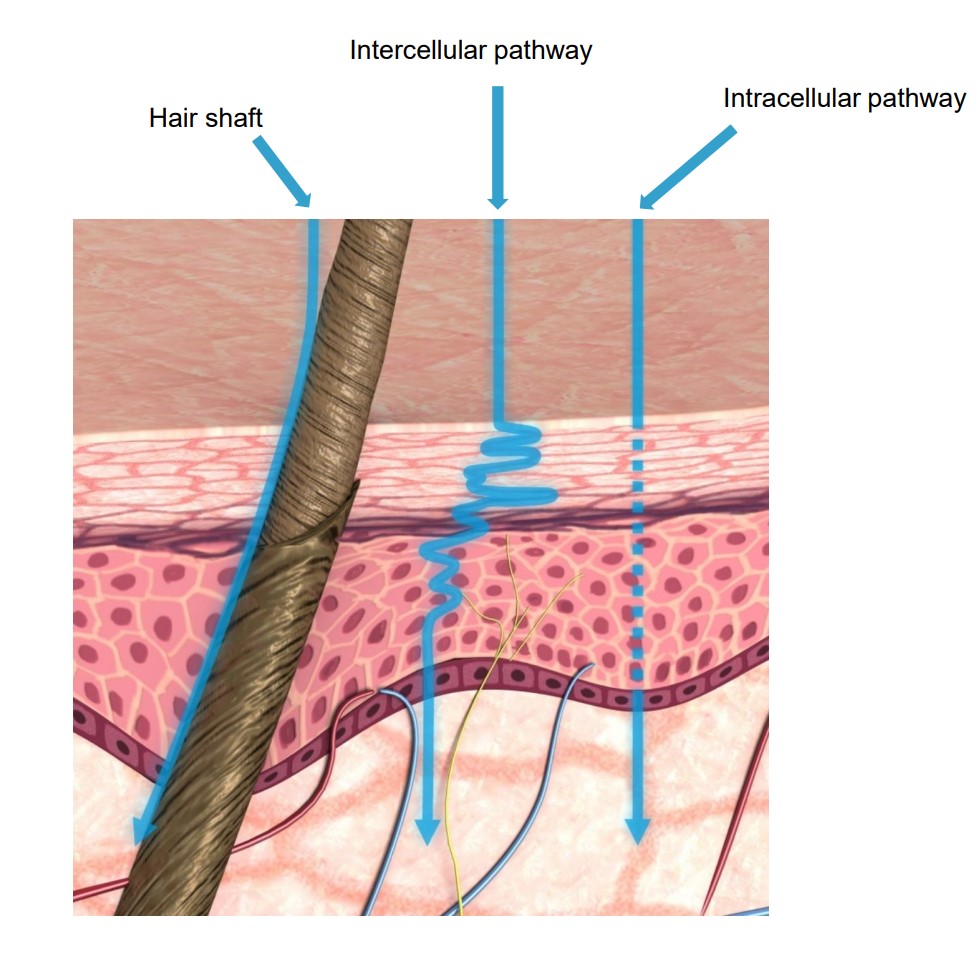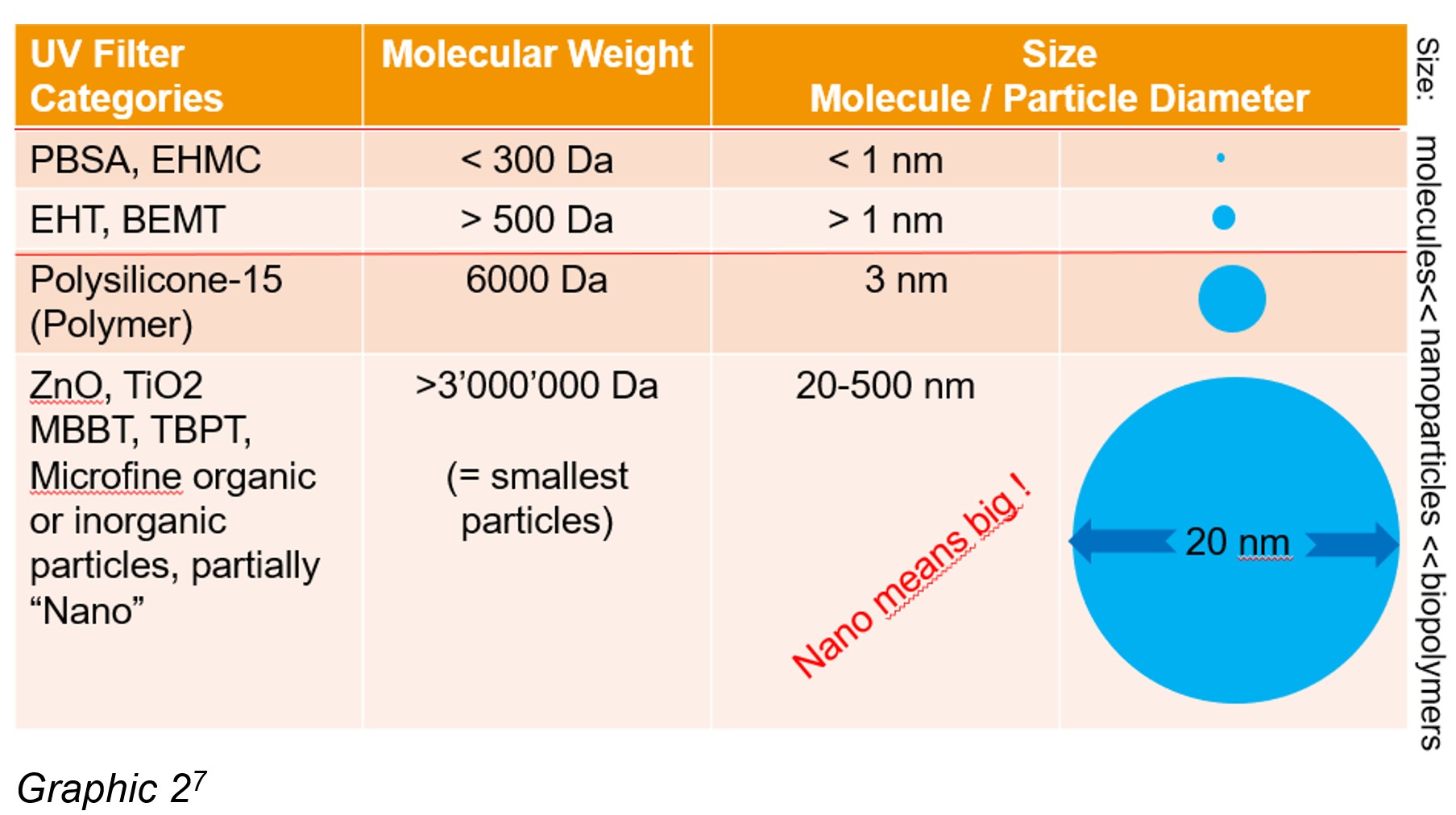
Responsible UV protection
Principles and parameters of skin penetration in relation to UV filters
Sunscreens are designed to stay on top of the skin to enable UV filters to work efficiently. Skin penetration of UV filters is not desired and is considered during their development. The principle is easy: the larger the molecule and the lower its polarity, the lower the dermal penetration. It may sound surprising but in this context nano-sized UV filter molecules are the biggest ones. They are not able to penetrate the skin.
Abstract: The potential of cosmetic ingredients such as UV filters to penetrate the human skin depends on a variety of parameters and can be drastically reduced when designing for high molecular weight, hydrophobicity and polarity. Over the last 2-3 decades the dermal penetration probability of UV filters could be significantly lowered for instance due to the creation of nanomaterials. UV filters in nanoform are big and most unlikely to penetrate skin.
Information: Two recent studies performed by the US-Food and Drug Agency (FDA) investigated the penetration of US registered UV filters1,2. The 4 and 6 UV filters, respectively, (EHMC, OCR, EHS, BMDBM, BP-3, TDSA & HMS, abbreviations see below) considered had all been found in the blood of the test persons in detectable concentrations, indicating their skin penetration potential. Many of the UV filters available in the US were developed in the early to mid-20th century. This was prior to the contemporary available experimental and analytical tools for investigating skin penetration. Therefore, most of the UV filters registered in the US belong to the group of small molecules and were not designed to follow the above-described criteria.
Contrary to the US, many of the UV filters which have been registered in the EU in recent years were developed after the discovery of the impact of different parameters of chemical structures on their skin penetration potential. Contrary to pharmaceutical products, for which it is most desirable to enter the skin, sunscreen products are designed to stay on the skin surface. Hence, most of the UV filters registered in the EU today have a significantly lower probability of penetrating the skin.
The skin is the body´s largest organ. It is made of three layers, each of which has specific functions and protective properties. There are three different ways through which substances can penetrate the skin:
- The appendageal route via the hair shaft
- The intracellular route via transport within a cell
- The intercellular route moving around the different cells
Thus, by applying results of pharmacological research it is possible to influence the likelihood of dermal penetration by the design of the structure specifically the UV active ingredient and the composition of the sunscreen. Therefore, most of the UV active ingredients, which were developed and marketed since the late 1990s, have a high molecular weight, show only limited polarity and are hence unlikely being absorbed by the skin.
These parameters reduce the potential for passing the skin (see graphic 1). Skin penetration is even more unlikely, when the large molecules are crystallized and form nano particles, another route to avoid dermal penetration.
As visualized in graphic 2, the step of moving to crystalline nano particles increases the virtual molecular weight significantly.
The UV filter development by BASF for the European market took the evolving scientific knowledge into account and minimized the penetration of UV filters out of sunscreens into the skin. Modern UV filters are safe-by-design as well as evaluated and approved by the independent experts of the EU Scientific Committee on Consumer Safety (SCCS). Therefore, consumers in the EU can feel safe utilizing sunscreens to protect themselves against skin cancer.
Sources
1 Matta M.K. et al, Effect of Sunscreen Application Under Maximal Use Conditions on Plasma Concentration of Sunscreen Active ingredients, Journal of American Medical Association May 6, 2019
2 Matta M.K. et al, Effect of Sunscreen Application on Plasma Concentration of Sunscreen Active Ingredients, Journal of American Medical Association January 21, 2020
EHMC: Ethylhexyl Methoxycinnamate; BP-3: Benzophenone-3; EHS: Ethylhexyl Salicylate; BMDBM: Butyl Methoxydibenzoylmethane; OCR: Octocrylene; TDSA: Terephthalylidene dicamphor sulfonic acid; HMS: Homosalate
3 Wiechers, J.W., et al., Predicting Skin Penetration of Actives from Complex Cosmetic Formulations: An Evaluation of Inter Formulation and Inter Active Effects during Formulation Optimization for Transdermal Delivery. International Journal of Cosmetic Science, 2012. 34(6): p. 525-35.
4 Bos, J.D. and Meinardi. M., The 500 Dalton Rule for the Skin Penetration of Chemical Compounds and Drugs. Experimental Dermatology, 2000. 9(3): p. 165-9.
5 Brian C. Palmer, Nanoparticles enabled transdermal drug delivery systems for enhances dose control and tissue targeting. Molecules 21 (12) December 2016
6 Annette L. Bunge and Robert L.Cleek, A New Method for Estimating Dermal Absorption from Chemical Exposure: 2. Effect of Molecular Weight and Octanol-Water Partitioning Pharmaceutical Research volume 12, pages 88–95 (1995)
7 PBSA: phenylbenzimidazole sulfonic acid; EHMC: Ethylhexyl Methoxycinnamate;; EHT: Ethylhexyl Triazone; BEMT: Bis-Ethylhexyloxyphenol Methoxyphenyl Triazine;; MBBT: Methylene Bis-Benzotriazolyl Tetramethylbutylphenol; TBPT: Tris-Biphenyl Triazine,



